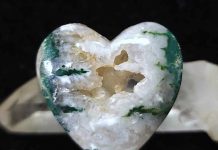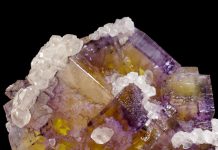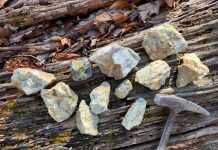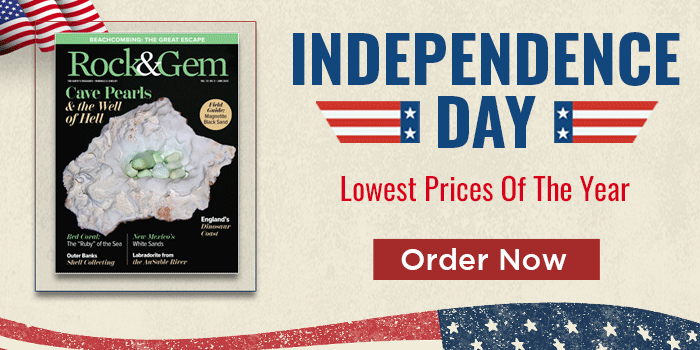
De Re Metallica is often cited in the bibliographies of the modern literature of minerals, mining, assaying and smelting. But, what is this oft-cited pivotal work? This fact may seem surprising for a work that is 465 years old, but De Re Metallica is no ordinary book. An encyclopedic dissertation on mining and metallurgy, this book is one of the landmark achievements of the early Renaissance period. Based on personal observation and written in meticulous detail, it documents both period craftsmanship and the rudiments of science and is the first true example of modern technological literature.
NOTE: To enjoy the second part of this fascinating study of this transformative reference, click this link.
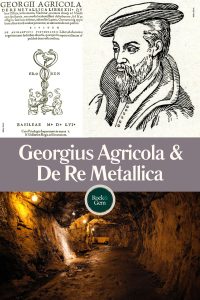
De Re Metallica (On the Nature of Metals) is the work of Georgius Agricola, a well-educated humanist scholar, physician, author, and de facto mineralogist and metallurgist. His achievements include describing 20 new mineral species, preparing the first systematic mineralogical classification system, recognizing bismuth and antimony as primary metals (elements), and, most importantly, writing a work of great historical significance that is still relevant today. Through its text and the original illustrations, De Re Metallica offers a fascinating look at mining and metallurgy in the first half of the 16th century.
The setting for De Re Metallica is the Erzgebirge (Ore Mountains) on the present-day border of the German state of Saxony and the Czech Republic’s Karlovy Vary district. The Erzgebirge is an intensely mineralized, 85-mile-long, 25-mile-wide range of mountains with summits rising to 4,000 feet.

Finding Inspiration in German Ore
By 2000 B.C., the Erzgebirge was already an important source of tin for Bronze Age metallurgists in the Mediterranean region and the Middle East. More than 3,000 years later, a silver strike in 1168 C.E. at Freiberg (now in Saxony, Germany) triggered a Berggeschrey (literally “mining clamor”), a mineral rush similar to those that would occur centuries later in the American West.
After these discoveries were depleted, the Erzgebirge stagnated again until the late 1400s, when even richer silver strikes touched off a second, much larger Berggeschrey. This rush attracted thousands and led to the founding or expansion of such mining towns as Schneeberg, Annaberg, Marienberg, and St. Joachimsthal, each the site of hundreds of underground mines that exploited vast systems of silver-rich, multimetal veins.
By the early 1500s, the Erzgebirge became the world’s largest silver source and its most technologically advanced mining center. It led the transformation of European mining and metallurgy from small-scale, craft-based, medieval operations to a large-scale, state-controlled industry fueled by capitalist investment. With its well-organized administrative, managerial, and social dimensions and riding a rising wave of applied science and technology, the Erzgebirge mining industry became a model for Europe’s later industrialization.
A Ringside Seat for Mining Technology
One individual who had a ringside seat for this exciting new world of advancing mining technology was Georg Bauer. Born in 1494 in Glauchau, Saxony, Bauer would make his mark in history as Georgius Agricola (the Latinized form of his birth name). Agricola had studied theology, philosophy, Greek, and Latin at the University of Leipzig, earning a degree in 1518 and later returning to study chemistry, physics, and medicine. After completing his medical studies in Italy, Agricola worked for a Venice book publisher. During his time at the publishing company, he met the Dutch philosopher and scholar Erasmus (Desiderius Erasmus Roterodamus), who encouraged him to write. Erasmus later became Agricola’s patron and published several of his books.
In 1528, Agricola accepted a position as a town physician in St. Joachimsthal (Jáchymov, now in Karlovy Vary, Czech Republic). With a population of 15,000, St. Joachimsthal was then a thriving center of silver mining and smelting with more than 600 operating mines. Over the next 70 years, the St. Joachimsthal district would produce 110 million troy ounces of silver. Today, this intensely mineralized district is the type locality for 31 of its 230 recognized mineral species. A government mint began turning out Joachimsthaler coins to utilize part of St. Joachimsthal’s prodigious silver production. Joachimsthaler, shortened in German to taler and the Dutch daler, would become the etymological base of our modern English word “dollar.”
Agricola’s medical responsibilities allowed him time to pursue a growing interest in mining and metallurgy. After reading all the available classical and medieval literature on these subjects, he befriended miners, mine owners, managers, assayers, and smelter workers to gain firsthand knowledge of their professions. Frequently visiting the mines and smelters, he observed and documented their operations, equipment, methods, and the St. Joachimsthal ores and ore deposits’ nature.
Mining Research Prompts a Career Change

Agricola relinquished his medical duties in 1530 to devote himself to writing about mining and smelting. He also published his first book, Bermannus; sive, de re Metallica Dialogues (Bermannus, or a Dialogue on Metallurgy), an account, told through a dialogue with a miner, of St. Joachimsthal’s mining and smelting practices. Bermannus was the first work to present practical knowledge in an orderly, scientific manner.
Previously, mining and metallurgy had been secretive fields with knowledge passed down by the spoken word and rarely through writing. The few written accounts, almost all of classical or medieval origin, were largely erroneous or alchemistic in concept. Agricola was the first to disregard these sources and base his writing only on personal observations or current information that he received directly.
Laying the Foundation
Agricola’s years in St. Joachimsthal shaped the rest of his life and provided the material for most of his books. In 1533, he left to accept a position as town doctor in Chemnitz, just north of the Erzgebirge, where he began work on what would become De Re Metallica. Meanwhile, Agricola published several other books. He laid the foundation of modern physical geology by discussing the origins of subterranean heat and explaining how water acts as a powerful geological force in De Ortu et Cousis Subterraneorum (On Subterranean Origins and Causes).
In De Natura Eorum Quae Effluunt e Terra (The Nature of Things that Flow from the Earth’s Interior), he describes how water forms many surface and subterranean geological features. In De Ortu et Cousis Subterraneorum (On Subterranean Origins and Causes) In De Natura Fossilium (On Natural Fossils); the word “fossil” then referred to any material from the Earth), he described the occurrence of minerals, ores, metals, gemstones, and igneous rocks. Disregarding the traditional alphabetical listing of minerals, he first attempted to classify minerals scientifically by their physical properties.
Embracing Science Fundamentals
As a true son of the Renaissance, Agricola embraced objective observation, logic, and science fundamentals. Throughout his work, he rejected alchemy, describing alchemical writings as “obscure” and observing that alchemists made no material contributions to society. Agricola also rejected the use of divining rods, which were then widely employed as prospecting tools. Divining rods are forked branches that, when properly held, supposedly twist downward to indicate the presence of subterranean mineral veins. This was based on the alchemistic notion that the “power” of mineralized veins attracted the forked branches of specific trees—hazel for silver, ash for copper, and pitch pine for lead and tin. Divining for gold, interestingly, required a copper divining rod.
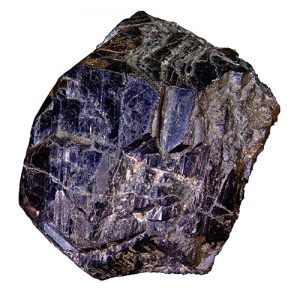
But even though he provided the first record of divining practices, Agricola nevertheless advised prospectors to “put aside the divining rods” and search instead for outcrops, springs, float, and unusual foliage colors that might indicate the presence of nearby mineralized veins.
Attempting to Classify Minerals
With no knowledge of modern chemistry or crystallography, Agricola understandably failed in his attempt to classify minerals by such properties as solubility, homogeneity, hardness, and color. But because he based his efforts on observation rather than hearsay and tradition, his work was a great advancement over those of the classical and medieval scholars. It was the forerunner of modern classification systems.
Until Agricola published his first books, the origin of mineralized veins was thought to have three possibilities. The “Genesis theory” proposed the contemporaneous formation of host rock and veins. The ancient Greek philosophers believed mineralized veins were “exhalations” caused by the interaction of Earth, air, water, and fire. The medieval alchemists, however, often linked vein origin to planetary alignment or the supernatural. But Agricola presented the revolutionary idea that water-based “juices” (aqueous solutions) circulate into rock fissures to solidify into “ore channels” (mineralized veins)—the first description of what we know today as hydrothermal vein emplacement.
This story is the first in a two-part series about De Re Metallica that previously appeared in Rock & Gem magazine. Click here to subscribe. Story by Steve Voynick.



